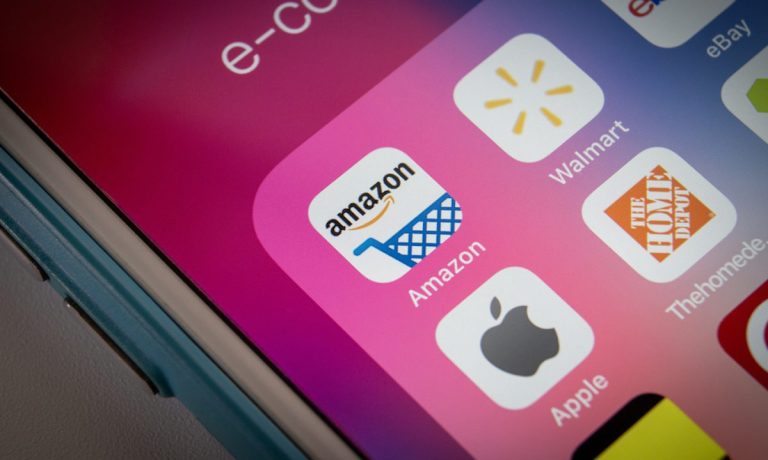
After vaulting ahead of Walmart in the fourth quarter last year, Amazon has held its front-runner status for the third quarter in a row, albeit by a razor-thin and shrinking margin.
So far, projections that Amazon was going to pull away from its rival and never look back have proven to be premature, as the big-box retailer’s investment in omnichannel capabilities has kept it in the race, with the two essentially tied – at least for now.
In the second quarter, PYMNTS data show, Amazon was able to hold onto its lead in the share of consumer retail spending for the third quarter in a row, against previous projections made in this space. Between the two retail titans, the share of consumer retail spending remained relatively unchanged between April and July, with Walmart gaining nothing and Amazon losing only one-tenth of a percentage point.
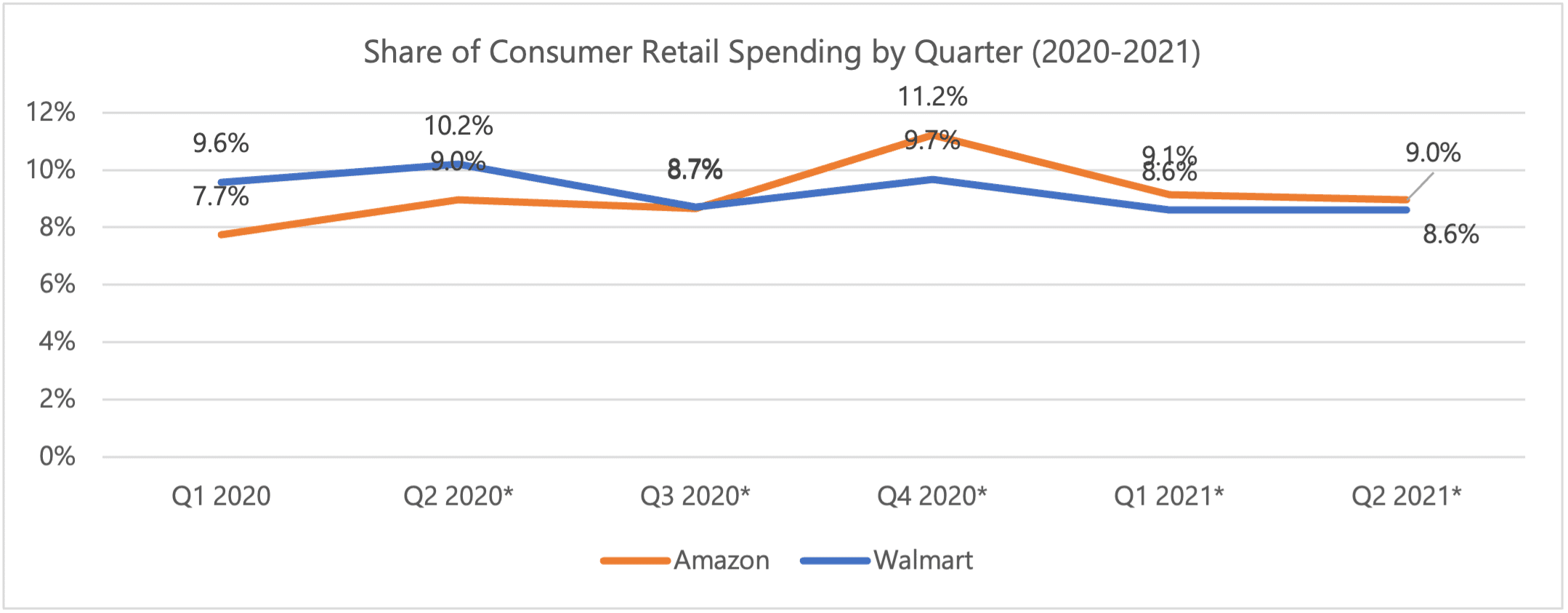
Source: PYMNTS data
Related: Amazon Will Outgrow Walmart 3-to-1 Over Next Five Years
PYMNTS’ proprietary data are derived from a gross market value standpoint, which tracks the full value of everything sold, not the actual revenue the companies earn by way of partial commissions on items sold through third parties on their platforms. For example, if Amazon sold a $50 set of knives but only booked $5 in revenue, assuming it charged the merchant a typical 10 percent referral fee, PYMNTS’ use of the former metric provides a more holistic view of where consumers are actually spending their money.
The speed at which Amazon has gained share is impressive, and while no doubt aided by COVID-19, the eCommerce giant was well on its way to eating Walmart’s lunch before the pandemic. In 2016 — just five years ago — Amazon had just 3.9 percent of the consumer retail spend per year, compared to Walmart’s 9.3 percent. And while Walmart remained relatively even in its share, accounting for 9.5 percent of consumer retail spend last year, Amazon gained over five percentage points, ending up with 9.2 percent.

Source: PYMNTS data
Looking at the share of total consumer spending, though, neither Amazon nor Walmart made any gains between the first and second quarter, remaining at 3.5 percent and 3 percent, respectively.
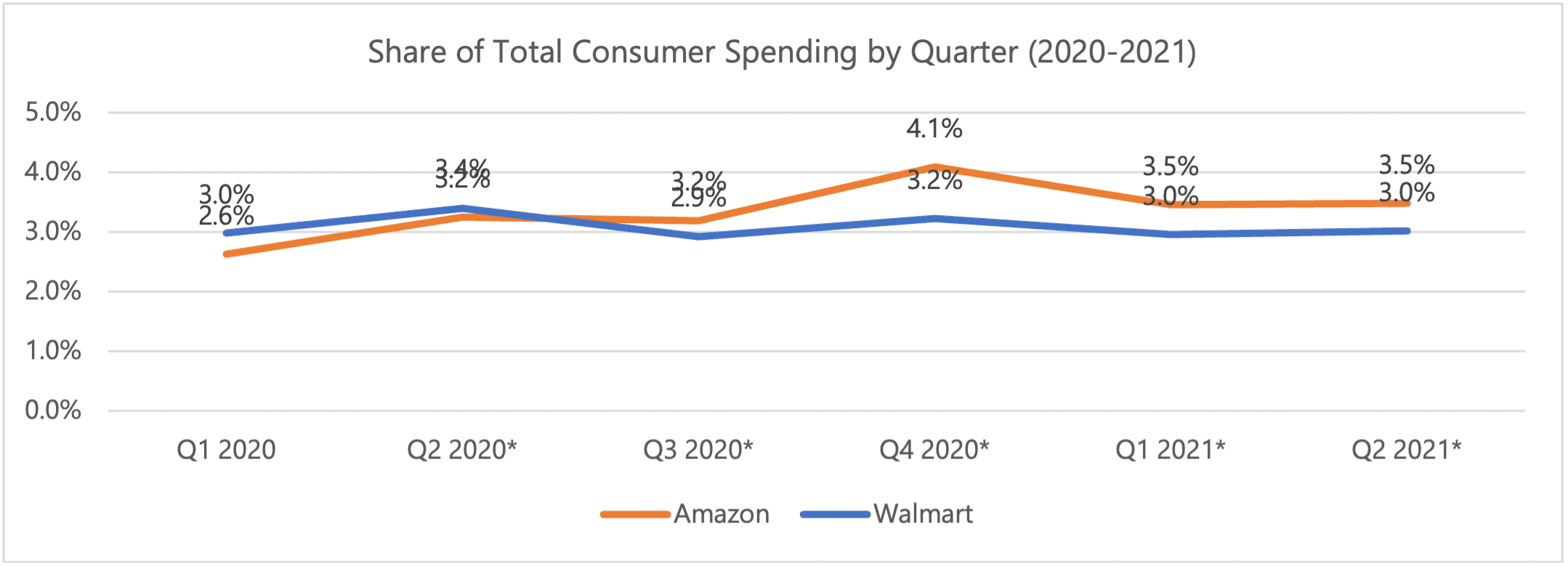
Source: PYMNTS data
A Tightening Wellness Race
Though Walmart has a nearly 2 percent lead in health and personal care, Amazon has gradually been making gains — it seems that consumers turned to the eCommerce giant at the beginning of the pandemic and liked what they saw, helping Amazon make a 1.2 percent gain in the category over the past 18 months. Walmart, meanwhile, has remained relatively steady in its share of consumers’ health and personal care spend, claiming nearly 6 percent in the second quarter.
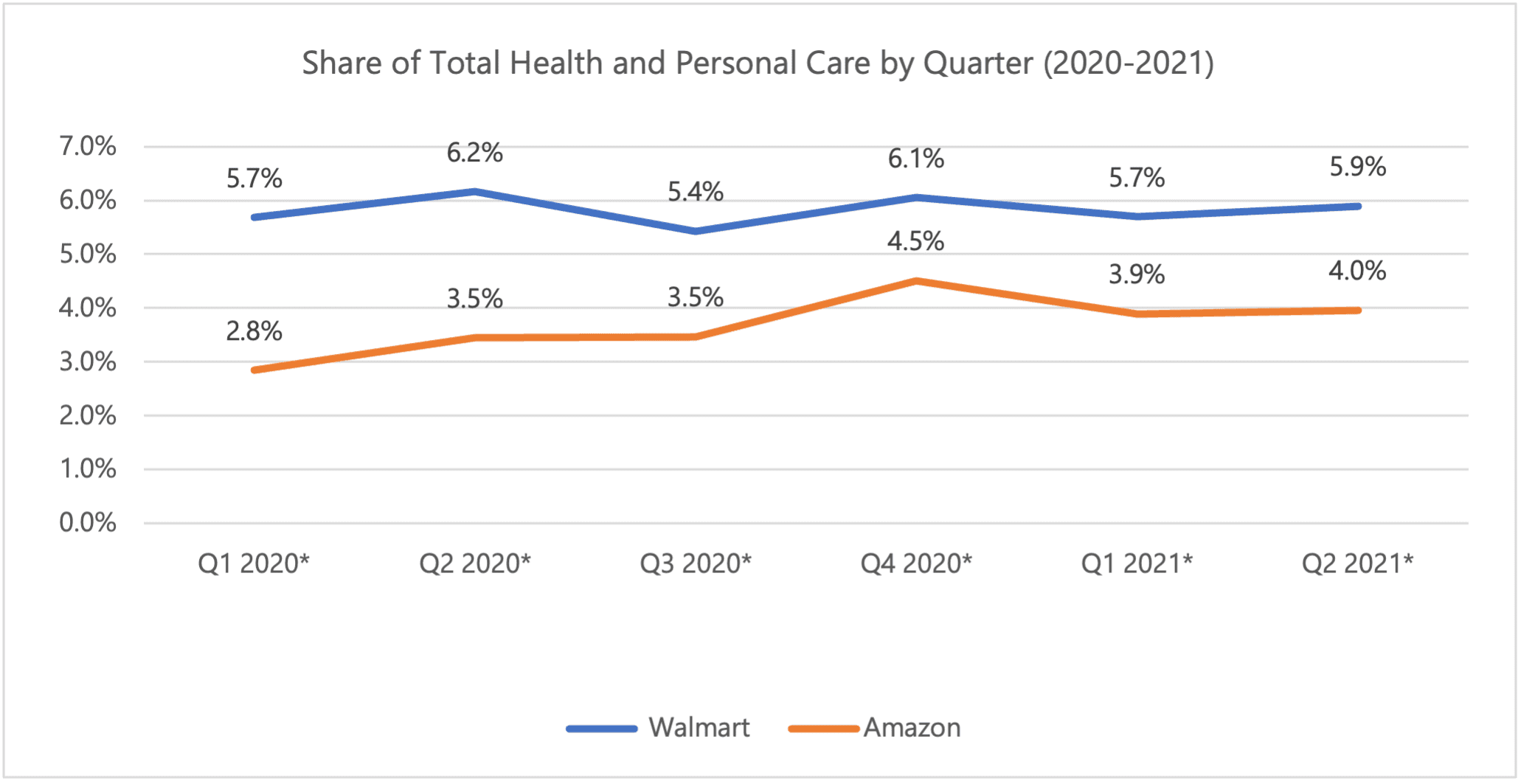
Source: PYMNTS data
Both Walmart and Amazon have made concerted efforts in recent months to make headway in healthcare as consumers, driven by the pandemic, place an increasing focus on their health and wellness. In June, the companies made news within hours of each other for their efforts to lower drug prices, just weeks before Walmart rolled out a private brand of insulin. Both companies are also making moves in telehealth, with Walmart acquiring MeMD and Amazon landing its first employer customer for Amazon Care, the company’s virtual primary care business.
Related: AMZN vs WMT Weekly: The War On Drugs Heats Up Over Prices
And as Walmart builds out Walmart+, one potential avenue of expansion is bringing food and health data together for consumers, executives hinted during a conference call with analysts and investors last week. “It’s how we stitch this whole thing together, from telehealth and the role that healthcare plays in the home, on mobile devices, how you triage a customer when they start to interact with you to direct them to the place to get the right care at the right time,” CEO Doug McMillon said.
But Amazon and Walmart aren’t the only big-name players stepping into the healthcare arena, making this area complicated and a bit crowded. Walgreens Boots Alliance Inc. and CVS Health Corp. are also increasingly trying to use their physical footprints to develop treatment centers for patients with costly conditions. Both expanded their telehealth offerings during the pandemic, and last year, Walgreens said it would attach doctors’ offices to hundreds of drugstores.
Amazon’s Grocery Struggles
One area in which Walmart can breathe a (slight) sigh of relief is grocery. Despite the acquisition of Whole Foods in 2017 and myriad Amazon Go stores opening in the last several years — as well as an increase in digital grocery sales — Amazon has been unable to move the needle when it comes to food and beverage.
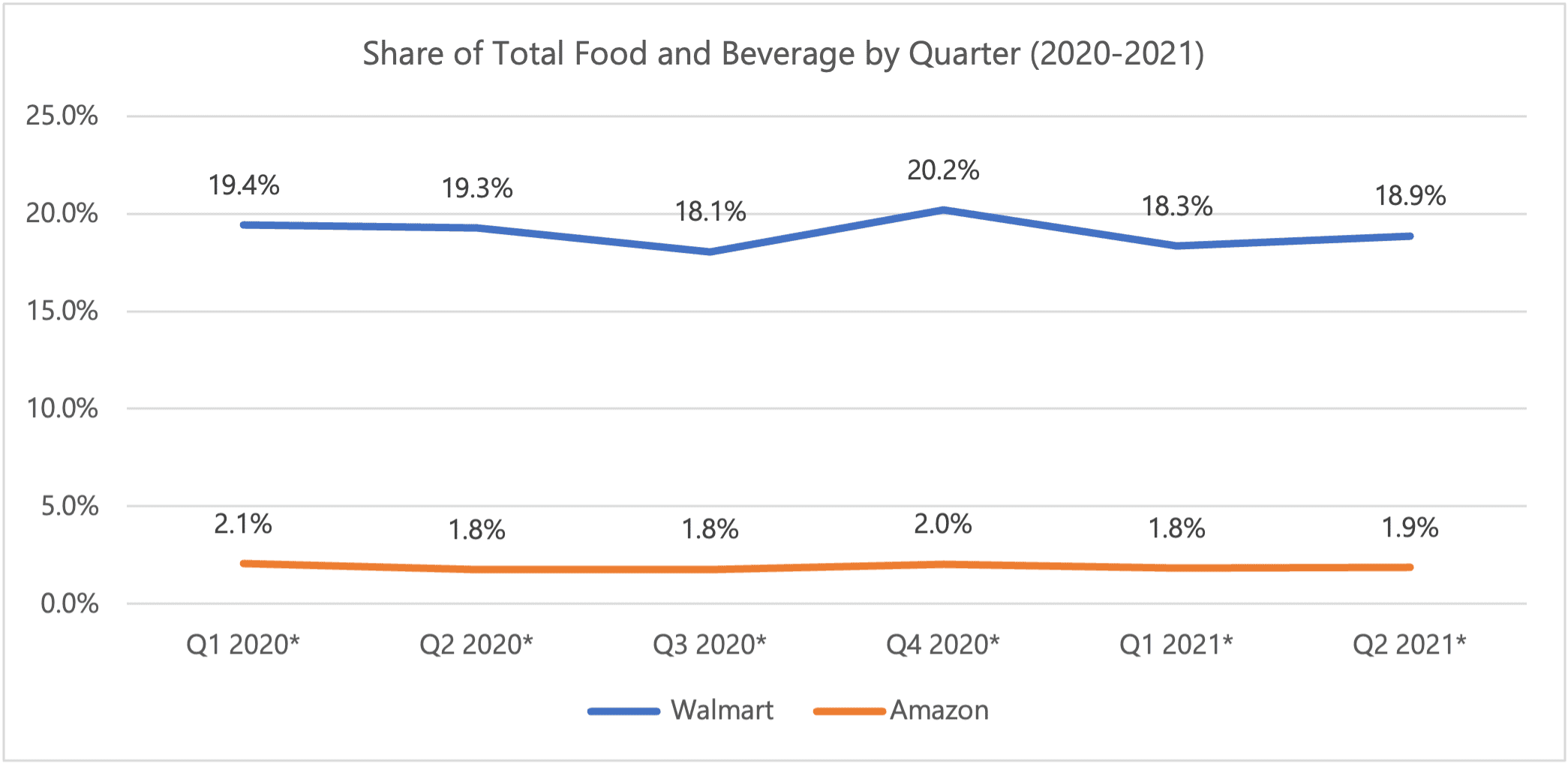
Source: PYMNTS data
As detailed in the chart above, Amazon has barely been able to crack a 2 percent share of consumers’ grocery spend in the past five quarters, while Walmart has remained steadily ahead by a nearly 10-to-1 margin. Walmart’s food and beverage sales in the second quarter reached over $66 billion, according to PYMNTS analysis, a 6.6 percent increase over the same period last year. Amazon, on the other hand, hit just $6.6 billion in grocery sales in the second quarter — still a nearly 17 percent year-over-year increase, but not enough to make a big difference.
To be sure, this doesn’t mean Walmart has nothing to worry about. Amazon, after all, is gaining sales, if not a substantial share, while Walmart seems to be gradually losing its edge. Even a return to in-person shopping, which Walmart executives touted as a key to the company’s success in recent months, wasn’t enough to push the retailer’s food and beverage share closer to its fourth-quarter high of over 20 percent.
Looking Ahead
As the past two years have proven for consumers and retailers alike, the future is uncertain, and there’s no telling what will happen in the coming months in this battle of the titans. But a few things are more likely than others: For example, Amazon will almost certainly continue to gain market share, and may end up surpassing Walmart as America’s top retailer by year-end.
But looking at recent earnings reports from the companies, it may be the case that Amazon is reaching the limit of how far eCommerce will take it. With eCommerce representing a little over 20 percent of all retail sales and Amazon already claiming nearly 50 percent of digital sales in the U.S., there’s only so much room left to grow online — which is why the next space to watch might be the physical realm. Walmart, after all, rode an omnichannel strategy to a strong second quarter.
Amazon, perhaps realizing this, has been building out physical retail concepts for books, groceries and curated highly-rated products. According to PYMNTS research, Amazon’s physical store revenue went up by 11 percent year over year in the second quarter, though it was down 3 percent compared to two years ago.
And Amazon’s next act appears to be taking shape in the form of department store-style locations, initially set for Ohio and California. The move is intended to expand Amazon’s footprint in retail sales of clothes, home goods, electronics and other categories. Amazon currently has over 500 Whole Foods Markets, approximately 26 Amazon Go locations, eight Amazon Fresh grocery stores, two Amazon Go Grocery stores, 24 Amazon Books stores and 29 Amazon 4-Star outlets, according to Supermarket News.
See: Amazon Hatching Strategy To Open Mega Brick-and-Mortar Stores